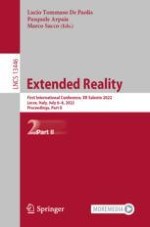This two volume proceedings, LNCS 13445 and 13446, constitutes the refereed proceedings of the 9th International Conference on Augmented Reality, Virtual Reality, and Computer Graphics, XR Salento 2022, held in Lecce, Italy, July 6–8, 2022. Due to COVID-19 pandemic the conference was held as a hybrid conference.
The 42 full and 16 short papers were carefully reviewed and selected from 84 submissions. The papers discuss key issues, approaches, ideas, open problems, innovative applications and trends in virtual reality, augmented reality, mixed reality, applications in cultural heritage, in medicine, in education, and in industry.
